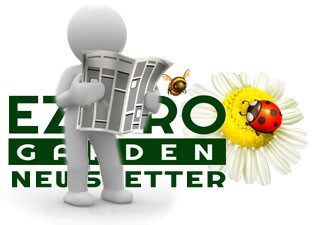EzGro Tiny Farm
What if we told you there was a way to make a substantial income, work for yourself, own a piece of property, and have no commute? For many, this may seem like a pipe dream. Here at EzGro, we’re making this a reality.
Enter the EzGro Tiny Farm, a self-contained, self-sufficient, working farm with a farm stand, completely off the energy grid. We’re developing plans for a kit for everything a family would need to start and operate a farm on a 1-acre plot of land, including a house to live in.
The Tiny Farm would include:
- Tiny Home, 16’ x 40’ with Geothermal Air Conditioner unit
- Greenhouse, 23’ x 60’
- 256-tower EzGro Garden, outdoors
- Farm stand with walk-in cooler & commercial kitchen
- Raised bed garden, 30’ x 80’
- Chicken coop, 20’ x 25’
- Slovene Bee House
- Digester Septic System
- Planted, Edible Border with 100,000-gallon Pond
Tiny Farm Home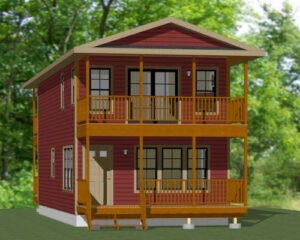


The two-bedroom home is perfect for either a family of two parents and one or two children, or two adults living together as roommates. The idea is that everyone who works on the farm can live on-site, eliminating the daily commute. By getting rid of the commute to work, families can save the precious time that many working parents spend in the car- and instead spend it with their family. Depending on the size of the lot, there may even be space for a second tiny home for employees or interns to live on the property as well.
 The home looks just like a standard house with both a front and back yard. A rainwater collection system stores water in five 20,000-gallon storage tanks that are buried underground, beneath the front yard. The back yard provides a perfect play area for children, away from the workings of the farm.
The home looks just like a standard house with both a front and back yard. A rainwater collection system stores water in five 20,000-gallon storage tanks that are buried underground, beneath the front yard. The back yard provides a perfect play area for children, away from the workings of the farm.
A Geothermal air conditioning unit is used to cool the home. The A/C’s compressor unit is wrapped with a water jacket, where flowing water significantly reduces the temperature of the compressor. By keeping the compressor cool, the whole unit runs much more efficiently.
 Greenhouse
Greenhouse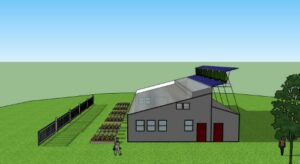
The 23’ x 60’ greenhouse is designed to start seedlings and grow out-of-season crops. For example, the farm will be able to grow tomatoes in winter and lettuce in the summer inside the greenhouse, maximizing profit at the farm stand. The Tiny Farm will include a Solar Windmill on the roof of the greenhouse to provide power for the entire operation.
 The climate controlled, 10’ x 60’ head end building inside the greenhouse is equipped with facilities to raise fish, microgreens, and lettuce. A 750-gallon aquaculture tank is where catfish, bass, and/or tilapia will be raised. The highest quality protein-rich feed will be fed to the fish because, after all, fish that are fed nutritious diets are healthiest for humans to eat. When the fish grow large enough, they can either be harvested directly from this tank, or transferred to the exterior pond to grow even larger. Catfish, for example, require plenty of space to reach a harvestable size in two years time.
The climate controlled, 10’ x 60’ head end building inside the greenhouse is equipped with facilities to raise fish, microgreens, and lettuce. A 750-gallon aquaculture tank is where catfish, bass, and/or tilapia will be raised. The highest quality protein-rich feed will be fed to the fish because, after all, fish that are fed nutritious diets are healthiest for humans to eat. When the fish grow large enough, they can either be harvested directly from this tank, or transferred to the exterior pond to grow even larger. Catfish, for example, require plenty of space to reach a harvestable size in two years time.
 Water from the aquaculture tank
Water from the aquaculture tank 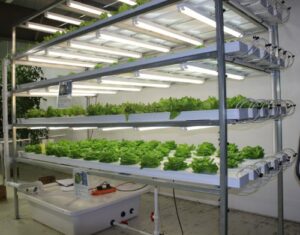 is used to fertilize lettuce plants growing in the Nutrient Film Technique (NFT) system. By using an NFT system, farmers can harvest lettuce on a weekly basis, easily replanting seedlings grown in coco-coir or rockwool cubes. “Living lettuce”, or lettuce with roots still attached, is sold to extend the life of lettuce plants for customers. Microgreens are harvested using a similar technique to prolong their shelf life. Microgreens are planted in coconut coir mats where they grow to a harvestable size in 7-16 days, depending on the type of green. The coir mats are cut into pieces, and the entire microgreen mat, root and all, is sold to the customer. This makes harvesting a breeze and ensures that plants remain in excellent condition when they arrive on the customer’s plate.
is used to fertilize lettuce plants growing in the Nutrient Film Technique (NFT) system. By using an NFT system, farmers can harvest lettuce on a weekly basis, easily replanting seedlings grown in coco-coir or rockwool cubes. “Living lettuce”, or lettuce with roots still attached, is sold to extend the life of lettuce plants for customers. Microgreens are harvested using a similar technique to prolong their shelf life. Microgreens are planted in coconut coir mats where they grow to a harvestable size in 7-16 days, depending on the type of green. The coir mats are cut into pieces, and the entire microgreen mat, root and all, is sold to the customer. This makes harvesting a breeze and ensures that plants remain in excellent condition when they arrive on the customer’s plate.
Farm Stand
The Farm Stand is the family’s main source of income. The farm stand is where roughly 2,000 pounds of produce per week will be sold to customers. A commercial oven and stove will be included inside the farm stand, allowing the family to cook and bake prepared foods to sell. Tomato sauce, pesto, pies, or breads, the possibilities of fresh, homemade foods that can be produced and sold are endless.
Outdoor Gardens
A 256-tower EzGro garden is where the family will grow most of the produce to sell at the farm stand. A large raised bed garden, just behind the greenhouse, is the perfect place to grow root crops such as carrots, tomatoes, onions, garlic and beets. By growing a variety of crops from potatoes to tomatoes to herbs, the farm will produce plenty of different crops to feed the family and to sell at the farm stand.
Chicken Coop & Yard
Located directly behind the backyard of the house will be a 20’ x 25’ area to raise chickens. This means 40-50 chickens will roam the pasture, pecking the grass for insects the way nature intended. Their diet will also include any produce that doesn’t look quite perfect enough to sell to customers. The hens will produce between 150-200 eggs each week, which is more than enough to feed the family, to sell at the farm stand, and bake into cookies, pies and other desserts to sell.
 Bee House
Bee House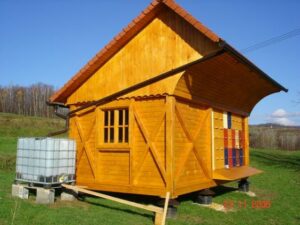
A Slovene Bee House, one of the time-honored methods of raising bees, will also be included on the property. Bees will provide honey galore, and will act as pollinators for all of the flowering plants on site.
Digester Septic System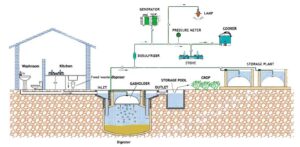
 Another key element in the Tiny Farm is the Digester Septic System, designed to break down both septic water and food waste. Once waste is processed using specialized bacteria, it is separated into liquid fertilizer and methane gas, for which the system includes holding tanks for both. Fertilizer will be used for crops in the permaculture and orchard area, and methane gas will be collected for use in the household stove. Excess methane gas will be burned in a decorative gas lantern in the lawn, providing ambient lighting for family gatherings. This septic system ensures that all waste is processed and used on site, and nothing is released into the environment. Everything is recycled and reused, creating a completely sustainable acre of farmland.
Another key element in the Tiny Farm is the Digester Septic System, designed to break down both septic water and food waste. Once waste is processed using specialized bacteria, it is separated into liquid fertilizer and methane gas, for which the system includes holding tanks for both. Fertilizer will be used for crops in the permaculture and orchard area, and methane gas will be collected for use in the household stove. Excess methane gas will be burned in a decorative gas lantern in the lawn, providing ambient lighting for family gatherings. This septic system ensures that all waste is processed and used on site, and nothing is released into the environment. Everything is recycled and reused, creating a completely sustainable acre of farmland.
 Energy Efficient GAHT Heating and Cooling System
Energy Efficient GAHT Heating and Cooling System
Ground to Air Heat Transfer, or GAHT, systems are closed-loop systems for heating and cooling that utilize both the sun’s energy as well as the soil beneath the greenhouse. This is an extremely sustainable method of heating and cooling a space. This simple design operates a series of fans and pipes to store the sun’s warmth in the soil beneath the greenhouse. During the day and in summer months, excess heat is blown down into the soil. This process cools the greenhouse while warming the soil. At night or in the winter, fans blow the hot air from the soil back up into the greenhouse. It works best in the greenhouse application because of the unique ability for the transparent walls to allow plenty of the sun’s energy to enter the space.
 The GAHT system has the unique ability to reduce humidity in the greenhouse, which decreases the occurrence of pests and disease in crops. Humidity levels rise during the day when the greenhouse heats up. The cool air from underground is drawn up into the greenhouse, and causes the humidity to condense into dew. This process further helps to cool down the space. In turn, the process decreases humidity because the water that was trapped in the air condenses and turns into dewdrops.
The GAHT system has the unique ability to reduce humidity in the greenhouse, which decreases the occurrence of pests and disease in crops. Humidity levels rise during the day when the greenhouse heats up. The cool air from underground is drawn up into the greenhouse, and causes the humidity to condense into dew. This process further helps to cool down the space. In turn, the process decreases humidity because the water that was trapped in the air condenses and turns into dewdrops.
Air circulation is important for crop health as well. When air is moving, there are fewer pests and less disease, which makes for healthier crops. The fans in the GAHT system ensure that there is always air being circulated through the greenhouse from the soil or from the air outside of the greenhouse. The fans in this system, by the way, require MUCH less energy to operate than a traditional HVAC system, making the GAHT system the most sustainable solution for climate control in greenhouses on the market today.
This method has been used in different time periods all over the world. One similar method is called “Climate Batteries”. “Earth Tubes” are similar, but they do not use a closed-loop system like the GAHT. Earth Tubes are a one-way heat transfer system.
Permaculture and Fruit Orchard Border with 100,000-gallon Pond
The Tiny Farm is meant for a 1-acre property, which allows for plenty of space for a 20’ x 150’ buffer on three sides of the property. This space will be planted with a fruit orchard in a permaculture setting, as well as a 100,000-gallon pond. The planted area will serve as a privacy screen on three sides of the lot, as well as provide space for ecologically sound permaculture design. The area will use companion plants and flowering plants to attract pollinators and beneficial insects to the property.
The large pond will be 20’ wide, 70’ long, and 10’ deep and hold 100,000 gallons of water. When the hydroponic systems need to be flushed, the nutrient-rich water will be directed to the pond, again keeping all nutrients on-site for reuse. The large body of water will ensure the nutrients are extremely diluted, so it will not affect the fish. The nutrients will feed the algae, which the fish will eat. The depth of the pond will provide necessary warmth underground for fish to hibernate during winter months.
Property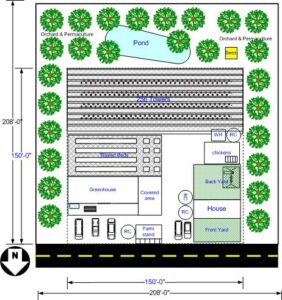

It will be up to the farmers to find their own plot of land and EzGro will take care of the rest. Ideally, the farmers would purchase at least one-acre plot of land’. These measurements are estimates of course, and each component mentioned above can fit in an area smaller than that.
The best location for a Tiny Farm would be in a suburban setting close to other businesses, with a road on the north side of the property. One wall of the greenhouse will serve as a backdrop for the parking lot for customers visiting the farm stand. Of course before purchasing land, the ambitious farmers will need to learn about local laws and restrictions regarding selling homemade food and home-grown produce.
The Tiny Farm will be a viable source of income for families eager to get “back to basics” and live a simpler life, away from offices, traffic, and the typical daily grind. The Farm is meant to be a full-time job for two people, and while it is hard work, it can also be some of the most rewarding work there is. The farm will yield $100,000 per year based on constant, year-round production. Finding a job where you can work at home, be your own boss and spend much of the day out in nature is something many people desire.








